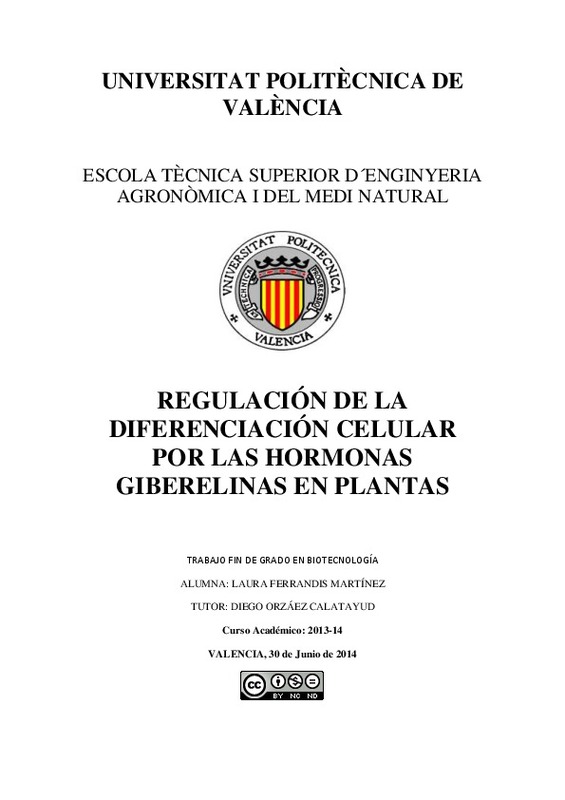|
Resumen:
|
[ES] El desarrollo de las plantas es en su mayoría post-embrionario. Tras la
germinación, los nuevos órganos se originan en dos zonas localizadas en los polos opuestos de
la planta y que se denominan meristemos apicales, ...[+]
[ES] El desarrollo de las plantas es en su mayoría post-embrionario. Tras la
germinación, los nuevos órganos se originan en dos zonas localizadas en los polos opuestos de
la planta y que se denominan meristemos apicales, del tallo (SAM) y de la raíz (RAM). Los
meristemos contienen las células madre, que se mantienen continuamente en un estado
indiferenciado. La identidad de las células en el SAM se mantiene gracias a la actividad de los
factores de transcripción (FTs) KNOTTED1-LIKE HOMEOBOX (KNOX). Por el contrario, la
actividad KNOX está reprimida en los flancos de SAM donde se originan los nuevos órganos –
hojas o inflorescencias- gracias a la actividad de otros FTs, los TEOSINTE
BRANCHED1/CYCLOIDEA/PCF (TCPs) y ASYMMETRIC LEAVES1 (AS1), que promueven
diferenciación celular. La hormona giberelina (GA) también juega un papel importante promoviendo diferenciación
celular aunque no se conoce el mecanismo por el que ejerce este control. Se ha descubierto
que las proteínas DELLA, que son los reguladores negativos de la señalización por GAs y son
degradadas en respuesta a la hormona, son capaces de interaccionar físicamente con los TCPs
en Arabidopsis thaliana. En este trabajo se prueba la hipótesis de que las GAs inducen
diferenciación en la zona apical del tallo promoviendo la actividad de los TCPs. Para ello se ha
estudiado cómo se ve influenciada la expresión génica de AS1, una diana directa de los TCPs,
mediante ensayo histoquímico GUS realizado en fondos mutantes capaces de expresar GUS allí
donde se expresa AS1 y mutantes con ganancia de función de los TCPs.
Por otra parte, la realización de ensayos de cuantificación de RNA mensajeros mediante la
técnica de qRT-PCR en fondos silvestres y mutantes con la señalización por GAs alterada, puso
de manifiesto que las DELLAs no ejercen una regulación transcripcional sobre los genes TCPs.
[-]
[EN] The development of plants is mainly post-embryonic. After germination, new
organs are originated in two opposite regions of the plant and they are called the shoot (SAM)
and the root (RAM) apical meristems. These ...[+]
[EN] The development of plants is mainly post-embryonic. After germination, new
organs are originated in two opposite regions of the plant and they are called the shoot (SAM)
and the root (RAM) apical meristems. These meristematic areas contain stem cells that are
continuously in an undifferentiated state. The identity of the cells in the SAM is maintained by
the activity of transcription factors (TFs) knotted1-LIKE homeobox (KNOX). By contrast, KNOX
activity is repressed in the SAM flanks where new organs -leaves or inflorescences- are
developed. This is because other TFs, the teosinte BRANCHED1/CYCLOIDEA/PCF (TCPs) and
ASYMMETRIC LEAVES1 (AS1) promote cell differentiation.
The plant hormone gibberellin (GA) also plays an important role in promoting cell
differentiation. However, the mechanism by which exercise this control is not known. It has
been discovered that DELLA proteins, which are negative regulators of signaling by GAs and are
degraded in response to the hormone, are capable of physically interact with TCPs in
Arabidopsis thaliana. Here, we test the hypothesis that GAs induce differentiation in the shoot
apical region by promoting activity of TCPs. For this reason, we have studied the expression of
AS1, which is a direct target of TCPs, by histochemical GUS assay performed in mutant
backgrounds which express GUS where AS1 does and mutants with gain of function of TCPs.
Furthermore, RNA quantification assays by qRT-PCR technique were done in wild and mutant
GAs altered signaling backgrounds. These studies revealed that DELLAs do not work as
transcriptional regulators of TCP genes.
[-]
|







